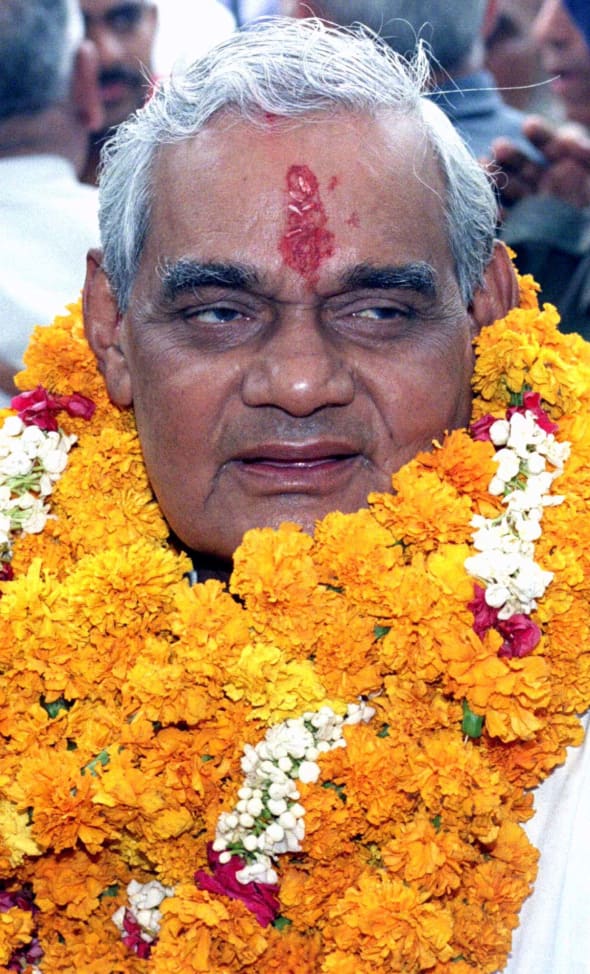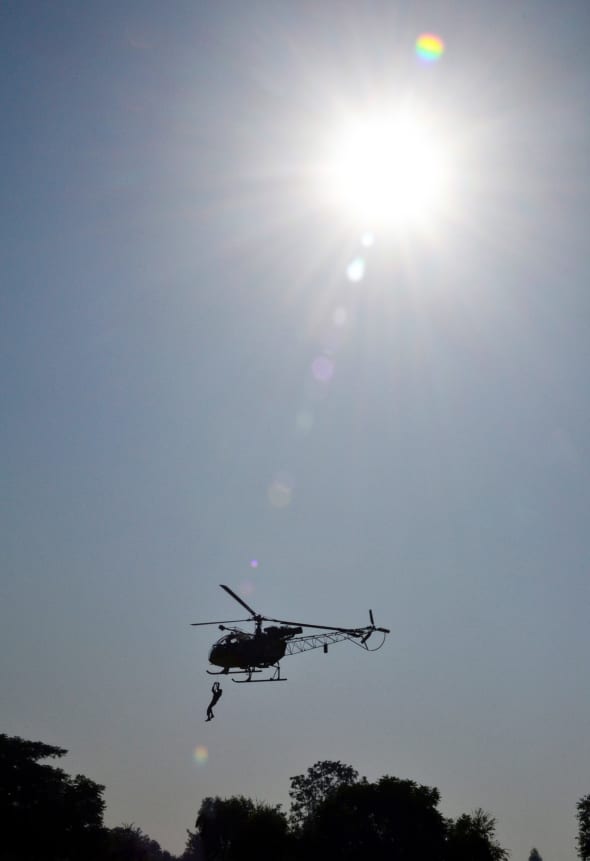EXCLUSIVE: In 2002, India's Fighter Jets Hit Pakistan In A Surgical Strike You've Never Been Told About
The untold story of an incredible Indian Air Force secret mission during Operation Parakram.
27/01/2017 10:29 AM IST |
Updated 6 minutes ago
AFP/GETTY IMAGES
An undated Defence Ministry photograph shows an Indian Air Force French-made Mirage 2000 jet.
It was about 2 am on 31 July, 2002. Flight Lieutenant Rajiv Mishra, a 29-year-old fighter pilot, was woken up at his living quarters at the Ambala Air Force Station. Leave for Srinagar immediately with laser designation equipment, he was told. A transport aircraft was ready and waiting at the base.
He didn't know it then, but he had been drafted for one of the most sensitive missions carried out by the Indian Air Force, the details of which had never been revealed to the outside world, until now.
Mishra flew the Jaguar fighter jet of the Indian Air Force. But that night he had not been woken up to fly. The IAF had recently acquired laser guidance systems from Israel. The technology helped fighter pilots to hit targets accurately once the target has been designated on the system. Mishra was regarded a wizard with the new technology.
Mishra flew the Jaguar fighter jet of the Indian Air Force. But that night he had not been woken up to fly.
On board the transporter, Mishra and his two colleagues were briefed by the members of the IAF Strike Cell, the elite frontline strike unit of the force, comprising the most skilled fighter pilots and the most lethal aircraft. The mission was stunning — they had to "light up" Pakistan positions along the Line of Control — the de facto border. 'Light up' is military talk for designating a target on the laser guidance system. They grasped the implication immediately: Indian fighter jets would lock on and hit the Pakistani positions, something the IAF has rarely done during peace time.
It was a sensitive moment in the fraught India-Pakistan ties. Militants had stormed the Indian Parliament just seven months ago, in December 2001, triggering a massive military mobilization and standoff on both sides of the border and along the Line of Control. India called it
Operation Parakram.
'Light up' is military talk for designating a target on the laser guidance system. They grasped the implication immediately: Indian fighter jets would lock on and hit the Pakistani post, something the IAF has rarely done during peace time.
BJP's Atal Bihari Vajpayee was Prime Minister and George Fernandes the defence minister. Between May and June 2002, tensions between India and Pakistan were at its heights, following the
Kaluchak massacre in May and a failed mediation effort by Russian president Vladimir Putin.
India's defence apparatus suspected a Kargil-like troop build up situation near a border post in the Kel area in the Kupwara sector. Pakistani troops were raining shells on Indian positions from there. There was a need for strong retaliation.
The initial plan was to send in the India Army to attack the Pakistani positions. But the plan was changed after quick consultation with the then Army Chief, General Sundararajan Padmanabhan. Instead of a ground assault, it was decided to soften Pakistani positions using the IAF before the
Special Forces went in.
KAMAL KISHORE / REUTERS
Then Prime Minister Atal Bihari Vajpayee weighted under garlands put on by his supporters at his residence.
"Typical cold start doctrine in the Air Force terminology was put in practice. The details of this should remain cold. No one should talk about it. What it was intended for was successful," then Chief of Air Staff, Air Chief Marshal Srinivasapuram Krishnaswamy, told HuffPost India.
This account has been pieced together by speaking with multiple people directly involved with the operation. All of them agreed to speak, following months of persuasion, on the condition of anonymity. The IAF declined to comment, as did Flt Lt Mishra, who is now a retired officer and works as a commercial pilot. Typical for a special operation, this mission carried no name.
"Light It Up"
In the tense summer of 2002, the task of carrying out the strikes fell on the Western Air Command. Fighter aircraft including the French-made Mirage 2000, British-made Jaguar fighters and the Russian MiG-21 were moved to forward bases. While the mission was planned to take off from Srinagar, all forward air bases on the West Border were put on alert to be ready for a potential Pakistan retaliation.
That is when Flt Lt Mishra and two colleagues were tasked with "lighting up" the target. Today this can be done using different and more advanced technology. In 2002, it required someone operating from the line of sight of a target to designate it on the laser guidance system. That was going to be the job of the three-men team led by Flt Lt Mishra.
The Half Hour Wait
On the night of 31, senior officials met for the last time at Srinagar go over the details. New Delhi was informed after all ends were tied up. The team was told to wait. Nearly half hour later, the message came back--it was green.
On first light, the team was air lifted from the Srinagar airport on 1 August. Doors of the single-engine Cheetah helicopter had been removed. They would soon find out why.
As the helicopter neared the LoC, they could hear the blasts from the incessant shelling underway. They flew low, close to the ground. When they neared a BSF post just on the LoC, the three men jumped. Their equipment was dropped from the helicopter, and was grabbed by two BSF soldiers. They immediately had to duck into a foxhole. Shells landed on the post even as the Cheetah swiftly moved away.
The IAF fighters had to climb three mountains before they could get close enough to the targets to designate them. They were operating at an altitude of 16,000 feet, with rarefied air, making breathing difficult.
AFP/GETTY IMAGES
An Indian soldier climbs down the Cheetah helicopter ladder during an air show in Jammu on November 6, 2011.
Missing Camouflage
The Pakistani positions were on an incline and covered with heavy foliage; it was impossible to light up the targets from a distance. They had to go closer. This eventuality had not been accounted for. This meant the IAF men didn't have any camouflage on them. If they walked from the BSF post further, they would be artillery fodder in minutes, because the helicopter movement would have alerted the Pakistani posts.
Time was ticking away — the operations could commence only after the targets had been well identified. They managed to source two camouflage jackets from the BSF post but the three men decided to march on anyway. On the way, they found trees splattered with blood. The night before, the Indian Army had foiled an infiltration bid. The bloodstains on the trees were that of the infiltrating terrorists.
The IAF team had to climb three mountains before they could get close enough to the targets to designate them. They were operating at an altitude of 16,000 feet, with rarefied air, making breathing difficult. Finally after much effort they could close enough to identify and designate the targets on the laser guidance system. Once the job was done, they fell back to a post that was jointly manned by the BSF and the Indian Army.
On the way, they found trees splattered with blood. The night before, the Indian Army had foiled an infiltration bid. The bloodstains on the trees were that of the infiltrating terrorists.
The Gathering Force
As Ft Lt Mishra and his two colleagues waited in a darkened bunker, Indian Army's Special Forces started moving into the post. Pakistani guns were in full flow. The only lantern in the bunker had been covered with black paper and put underneath a cot. Even a flicker of light would attract shells. Nonetheless, a Major of the Artillery Unit was calculating the Pakistani gun positions and relaying it back.
2 August 2002
As Ft Lt Mishra, his colleagues and the Special Forces waited, a bit of bad news came in--fighter jets weren't being able to take-off because of bad weather. As Pakistan continued to pound Indian posts, everyone dug in. The final assault was pushed back twice. Finally, at 1:30 pm on 2 August, the code came through. The fighters had taken off and the assault had begun.
Mirage-2000 fighters dipped over the horizon, locked on the laser beams and bombed the Pakistani bunkers in the Kel area in Kupwara sector. Due to the sensitive nature of the operation, we are withholding the number of aircraft used in operation and the exact location where the strike took place. The Pakistani bunkers were reduced to rubble. The casualties are unknown.
Shocked by the surprise air raid, the Pakistanis were quick to take counter-measures to confuse the second wave of fighter jets. Left with no option, The IAF team would break radio silence and communicate to the incoming fighters. They directed them correctly. Pakistan would open up its heavy artillery guns--this time to target the Army-BSF post on the LoC where they had taken refuge.
Due to the sensitive nature of the operation, we are withholding the number of aircraft used in operation and the exact location where the strike took place. The Pakistani bunkers were reduced to rubble. The casualties are unknown.
Ft Lt Mishra and his team would soon begin their long trek back to safety as the Indian Army's Special Forces moved in to eliminate any remaining Pakistani soldiers. By evening the Pakistani guns had fallen silent.
Pakistan never retaliated to the 2002 air strikes. The Vajpayee-led NDA government at the time was happy to keep the strikes under wraps. That the Indian Air Force and the Indian Army were deployed to destroy Pakistan's military capabilities remained known all these years to just a handful of people in the political and civilian leadership, apart from those involved in the operation.
Flt Lt Mishra retired from the IAF as a Wing Commander.
Because the secret operation was never placed on record, no one involved has received a gallantry medal.
http://www.huffingtonpost.in/2017/0...india-s-fighter-jets-hit-pakistan-in-a-surgi/













 )
)
